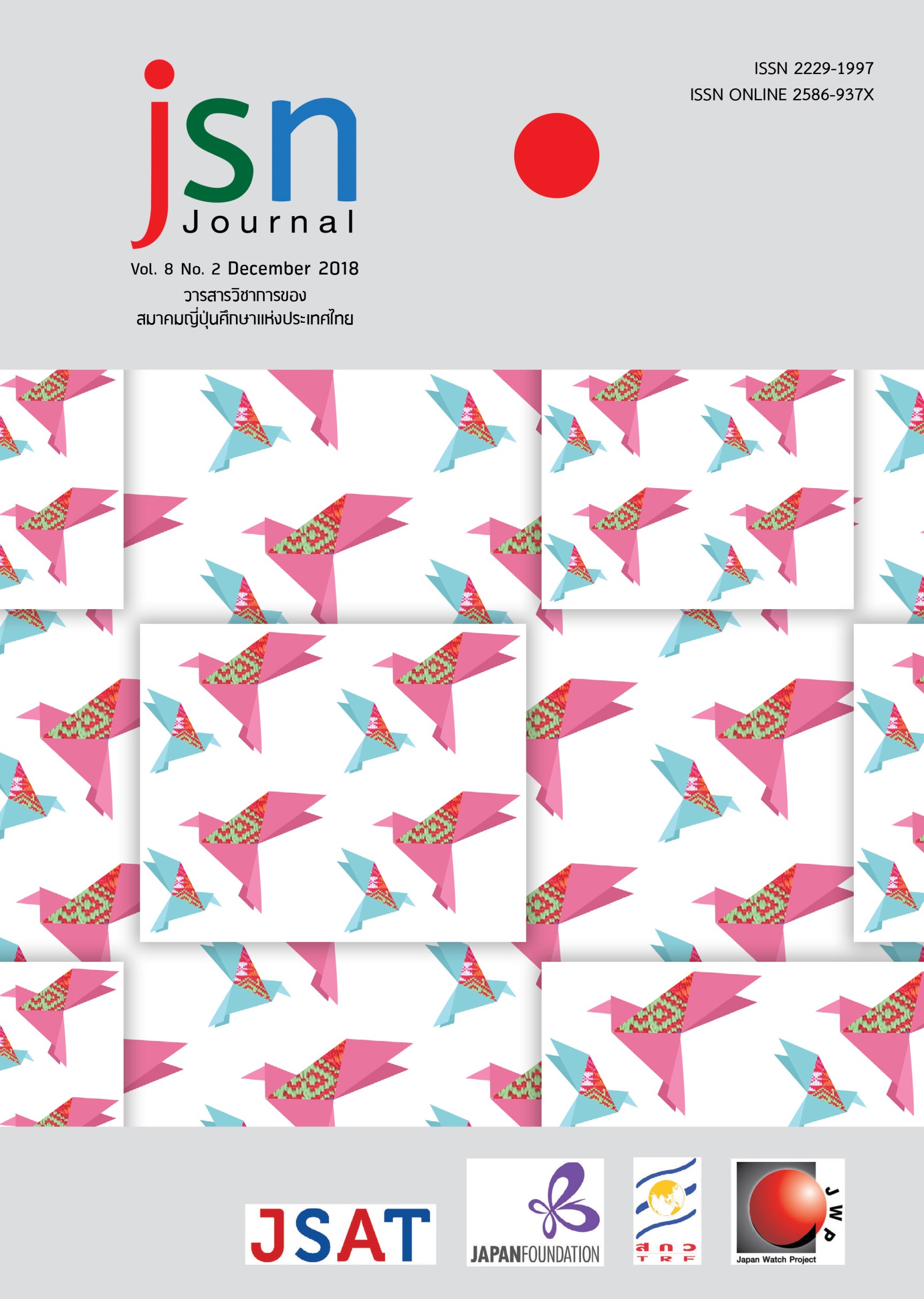ความคิดเห็นต่อกลยุทธ์การเรียนคันจิของผู้เรียนภาษาญี่ปุ่นชาวไทย: เปรียบเทียบความแตกต่างระหว่างความคิดเห็นของผู้สอนและผู้เรียน
Main Article Content
บทคัดย่อ
ในการเรียนคันจินั้น ผู้เรียนจะต้องเรียนทั้งรูป เสียงอ่าน ความหมาย และวิธีใช้ ทำให้มีข้อมูลที่ต้องจดจำเป็นจำนวนมาก เป็นเหตุให้การเรียนคันจิเป็นเรื่องยาก ดังนั้นการจะเอาชนะความยากลำบากในการเรียนคันจิ จำเป็นต้องใช้กลยุทธ์ที่เหมาะสม ผ่านมาจึงมีงานวิจัยเกี่ยวกับกลยุทธ์การเรียนคันจิจำนวนมาก แต่งานวิจัยที่ผ่านมาจะมุ่งศึกษาการใช้กลยุทธ์ของผู้เรียนเป็นหลัก ในงานวิจัยนี้จะศึกษาความคิดเห็นของผู้เรียนและผู้สอนชาวไทยว่า กลยุทธ์ใดจำเป็นต่อการเรียนคันจิ รวมทั้งผู้สอนและผู้เรียนมีความคิดเห็นแตกต่างกันหรือไม่อย่างไร และนำผลที่ได้ไปปรับปรุงการเรียนการสอนคันจิ
ในงานวิจัยนี้ทำการวิเคราะห์โดยแบ่งกลยุทธ์ออกเป็น 5 ประเภท ได้แก่ กลยุทธ์ด้านรูป เสียงอ่าน ความหมาย การใช้ และกลยุทธ์อื่นๆ ผลการวิเคราะห์พบว่า กลยุทธ์ที่ผู้ตอบแบบสอบถามโดยรวมคิดว่าจำเป็นต่อการเรียนคันจิมากที่สุดคือ กลยุทธ์ด้านรูป โดยเฉพาะกลยุทธ์การเขียนซ้ำๆ ในการเปรียบเทียบความคิดเห็นระหว่างผู้สอนและผู้เรียนพบว่ากลยุทธ์ที่ผู้สอนคิดว่าจำเป็นมากที่สุดคือ “เดาความหมายของคันจิจากบริบท” ส่วนผู้เรียนคือ “เขียนซ้ำๆ”
Article Details
ข้อความและข้อคิดเห็นต่างๆ ในบทความเป็นของผู้เขียนบทความนั้นๆ ไม่ใช่ความเห็นของกองบรรณาธิการหรือของวารสาร jsn Journal
เอกสารอ้างอิง
ชนัญญ์ธร รุ่งธัญนิธิธรณ์. (2554). การศึกษากลวิธีการเรียนคันจิของนักเรียนชั้นมัธยมศึกษาตอนปลาย. วารสารญี่ปุ่นศึกษา ฉบับที่ 28. 59-69.
ทัศนีย์ เมธาพิสิฐและคณะ. (2546). การสำรวจความต้องการของนักเรียนที่เรียนภาษาญี่ปุ่นในมัธยมศึกษาตอนปลาย. วารสารศิลปศาสตร์ มหาวิทยาลัยธรรมศาสตร์. ปีที่ 3 ฉบับที่ 1. 131-144.
Bourke, B. (1996). Maximing efficiency in the kanji learning task. Doctoral Dissertation. University of Queensland.
Gamage, G.H. (2003). Perceptions of kanji learning strategies: Do they differ among Chinese character and alphabetic background learners?. Australian Review of Applied Linguistics, 26.2, 17-31.
Oxford, R.L. (1990). Language learning strategies: What every teacher should know. New York: Newbury House.『言語学習ストラテジー-外国語教師が知っておかなければなら ないこと-』(宍戸通庸、伴紀子共訳 (1994) 凡人社).
ヴェントゥーラ・フランチェスカ (2007). 「フィリピン人日本語学習者と教師の漢字学習に対す るビリーフとストラテジー使用-漢字教育の改善のために-」『日本語文化研究会論集』3、国 際交流基金日本語国際センター,141-168.
ウランバヤル・ツェツェグドラム(2009).「漢字学習ストラテジーに関する研究の現状と課 題-非漢字圏日本語学習者にとっての効果的な学習ストラテジーとは-」『日本言語文化研究会 論集』5, 43-52.
大北葉子(1995).「漢字学習ストラテジーと学生の漢字学習に対する信念」『世界の日本語教 育』5,国際交流基金日本語国際センター,105-123.
加納千恵子(1994).「漢字の難しさ」『月間言語』23巻5,大修館,92-93.
________(1997).「非漢字圏学習者の漢字力と習得過程」『日本語教育論文集-小出詞子先生退 官記念-』, 凡人社,257-269.
________(2001).「外国人学習者による漢字の情報処理過程について-漢字処理技能の測定評価 に向けて-」『文芸言語研究言語編』39, 45-60.
________(2010).「漢字学習の困難点」『実践・漢字指導』濱川友紀代編集,くろしお出版,71-174.
ケオキサダン・パッチャラポーン (2008).「バンコクの国立大学の日本語専攻カリキュラム及び 評価基準の調査」『日本語教育国際シンポジウム「東南アジアにおける日本語教育の展望」』, 132-159.
小林英弘 (2017).「タイ人日本語学習者の漢字語彙学習に対するストラテジ-使用の現状」チュ ラーロンコーン大学文学部東洋言語学科修士論文.
齋藤禎子 (2003).「漢字学習ストラテジーと学習期間との関係-留学中のマレーシア政府派遣留 学を対象とした調査から-」『山形大学日本語教育論集』5,山形大学教育学部日本語教育研究 室, 71-84.
トリーニ・アルド(1992).「非漢字系学習者のための入門期における漢字学習指導の一考察」 『世界の日本語教育』2, 国際交流基金日本語国際センター,65-76.
チャイヤケッタナン・ソムチャイ(2008).「タイ人日本語学習者の漢字学習に対するビリーフ とストラテジー使用」チュラーロンコーン大学文学部東洋言語学科修士論文.
中鉢恵一(2006).「漢字学習ストラテジー-漢字学習成功者と未成功者の違いについて-」 『東洋大学人間科学総合研究所紀要』5,東洋大学,75-93.
中村重穂(1997).「日本語学習者の漢字学習ストラテジーに関する調査と考察」『日本語教育研 究』33,財団法人言語文化研究所,107-122.
バンチョンマニー・ブッサバー(2016).「タイ人日本語学習者における漢字学習意識―学習困難 点及び情意的側面について―」日本語教育学会バリ大会予稿集.
坂野永理・池田庸子(1997).「非漢字圏学習者の漢字学習意識とストラテジー使用」『留学生教 育』14, 留学生教育学会,13-21.


